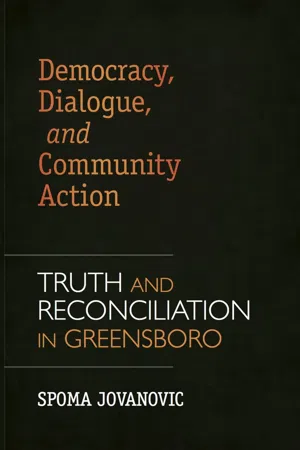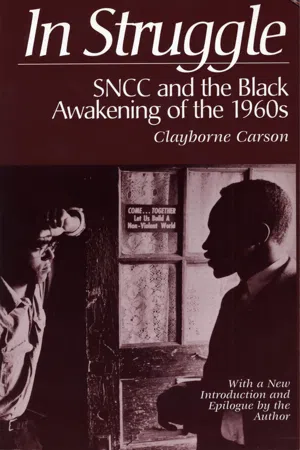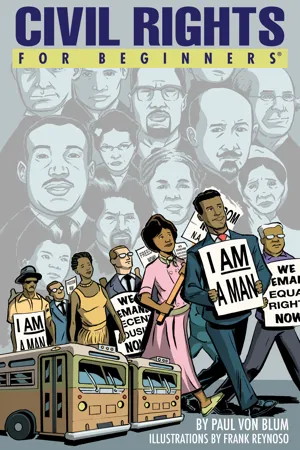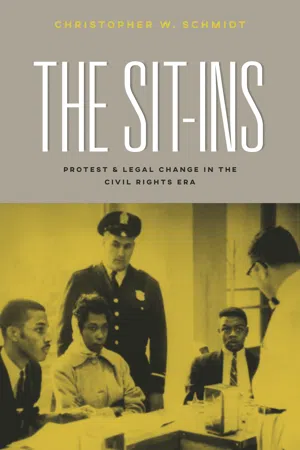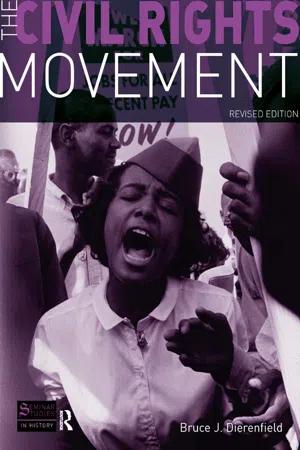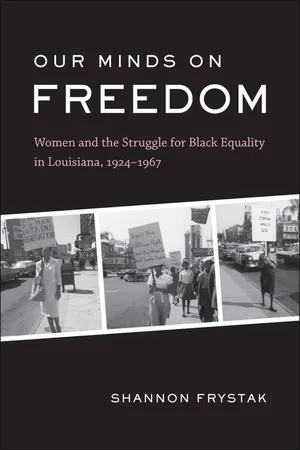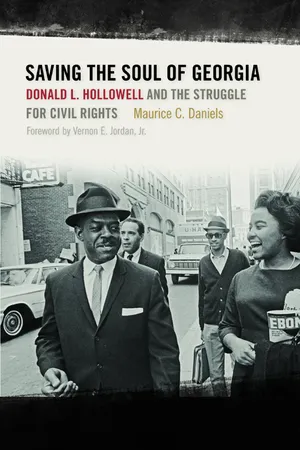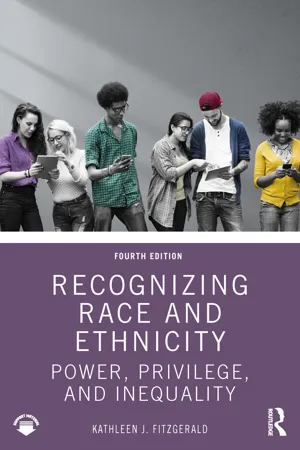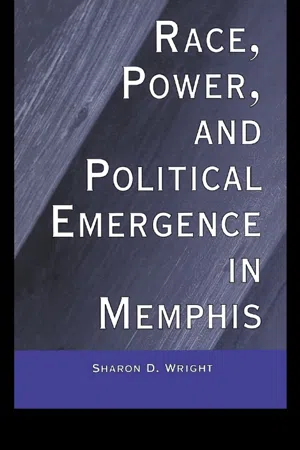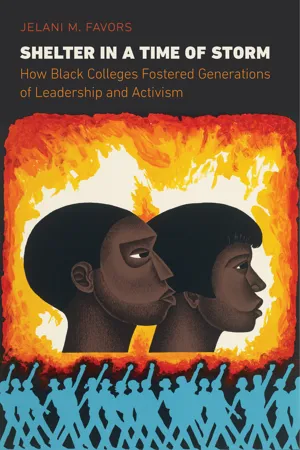History
Greensboro Sit-Ins
The Greensboro Sit-Ins were a series of nonviolent protests in 1960 where African American college students sat at segregated lunch counters in Greensboro, North Carolina. Their actions sparked a wave of sit-ins across the South and played a significant role in the Civil Rights Movement. The sit-ins challenged racial segregation and discrimination, leading to the desegregation of many public facilities.
Written by Perlego with AI-assistance
Related key terms
12 Key excerpts on "Greensboro Sit-Ins"
- eBook - ePub
Democracy, Dialogue, and Community Action
Truth and Reconciliation in Greensboro
- Spoma Jovanovic(Author)
- 2012(Publication Date)
- University of Arkansas Press(Publisher)
not one of the first to integrate, but in fact was one of the last cities to comply with the federal standard. Lewis Brandon III, a community activist and local historian, remarked, “Change doesn’t come because of the goodness of the people in the community. People have to struggle, people have to fight to get change in this community” (Final Report, 2006, 43).On February 1, 1960, Greensboro was the site of what would become known as the Sit-In Movement. Four black freshman college students from North Carolina Agriculture & Technical State University, frustrated and saddened by the racism they could not escape, decided to take action. Ezell Blair Jr. (later Jibreel Khazan), Franklin McCain, Joseph McNeil, and David Richmond walked to the Woolworth’s Department Store on Elm Street in downtown Greensboro to sit at the lunch counter where they knew they would be refused service. The store sold goods to all people, but the lunch counter was open only to whites. This double standard stood for the lifelong racial indignities experienced by the Greensboro Four and other blacks in the South. The resolve to act crystallized among the four young friends with determination and courage in what would become a worldwide, nonviolent protest action for racial justice (Chafe, 1980).Several times over the next six months, the sit-ins in Greensboro were suspended after negotiations with city and business leaders held out promises of change. But the rhetoric was empty, and so sit-in action resumed with shifts of college and high school students taking over the counter seats. Finally, the economic repercussions from the lost revenue at the lunch counter threatened the viability of the store, and that is when officials conceded to the demands for integration (Wolff, 1990). On July 26, 1960, the Greensboro Four were cheered for acquiring for all people the equal status they had sought, and what thousands of supporters in town demanded, and what the 70,000 people in more than fifty-five cities and thirteen states across America insisted upon with other sit-in actions (www.sitinmovement.org/history/greensboro-chronology.asp - eBook - ePub
In Struggle
SNCC and the Black Awakening of the 1960s, With a New Introduction and Epilogue by the Author
- Clayborne Carson(Author)
- 1995(Publication Date)
- Harvard University Press(Publisher)
PART ONECOMING TOGETHERPassage contains an image
1. SIT-INS
Late Monday afternoon, February 1, 1960, at a lunch counter in Greensboro, North Carolina, four black college students ignited one of the largest of all Afro-American protest movements. The initial spark of the movement was a simple, impulsive act of defiance, one that required no special skills or resources. Planned the previous night, the “sit-in”—as it would be called—was not the product of radical intellectual ferment. Rather, it grew out of “bull sessions” involving college freshmen who were, in most respects, typical southern black students of the time, politically unsophisticated and socially conventional. The four students would be influenced by the decade of social struggle that unexpectedly followed their protest far more than they affected the course of that struggle. Nonetheless, the initial sit-in contained the seeds of radicalism that would flower in SNCC, the principal organization to emerge from the black student sit-ins of 1960.The four students, like many other young activists of the 1960s, acted on the basis of suppressed resentments that preceded the development of an ideological rationale for protest. Without an organizational structure and without a coherent set of ideas to guide their actions, the Greensboro students were determined to break with the past. Only after their isolated protest had provided the stimulus for an intense, sometimes chaotic process of political education within the southern struggle would the four students become fully aware of the significance of what they had done. In the beginning, they only spoke of a modest desire: to drink a cup of coffee, sitting down.The initial sit-in was a tentative challenge to Jim Crow. Joseph McNeil and Izell Blair, roommates at the predominantly black North Carolina Agricultural and Technical College, along with two other students, Franklin McCain and David Richmond, purchased a few items at Greensboro’s downtown F. W. Woolworth store and then sat down at the lunch counter reserved by custom for whites. They asked to be served but were refused. When a waitress asked them to leave, they explained politely that as they had bought items in other sections of the store, they should be allowed to sit on the stools rather than stand. They received no sympathy from a black woman who worked behind the counter. “You are stupid, ignorant!” she chastised them. “You’re dumb! That’s why we can’t get anywhere today. You know you are supposed to eat at the other end.” Although refused service, the four students became more confident as they observed the lack of forceful opposition by the store employees. When informed that the four students were continuing to sit at the lunch counter, the store manager merely ordered his employees to ignore them. The students had expected to be arrested, but instead they discovered a tactic that not only expressed their long-suppressed anger but also apparently did not provoke severe retaliation from whites. “Now it came to me all of a sudden,” McCain remembered thinking. “Maybe they can’t do anything to us. Maybe we can keep it up.”1 - eBook - ePub
- Paul Von Blum, Frank Reynoso(Authors)
- 2016(Publication Date)
- For Beginners(Publisher)
In the days that followed, many more North Carolina A&T students, as well as those from nearby all-black women's Bennett College, joined the Woolworth's sit-in. By then, newspaper and television media coverage brought the action to broad public attention. The impact was swift and dramatic. On February 3, more than sixty people came to Woolworth's, and more than three hundred showed up on February 4. The protest spread to Kress, another five-and-dime store in Greensboro. Lunch counter personnel continued to refuse to serve them, white customers expressed hostility, and the sit-in demonstrators remained peaceful and polite.News of the Greensboro actions spread rapidly throughout the South. Sit-ins commenced in several other North Carolina cities and towns and to other states. One student in Nashville, John Lewis, who had attended workshops on nonviolence conducted by Reverend James Lawson, swiftly joined the emerging sit-in movement in Nashville. This led to the successful desegregation of lunch counters in that Tennessee city. Both Lewis and Lawson become nationally visible leaders in the nonviolent civil rights movement, with stellar moral and political accomplishments throughout the 20th and early 21st centuries.As the sit-in movement grew, white resistance intensified, especially when the targeted stores began feeling the adverse economic impact of the protests. White customers sometimes attacked sit-in participants physically, beating them with their fists and pouring catsup and other substances on them. Many demonstrators were arrested and white police officers often acted brutally, clubbing the sit-in participants while hauling them off to jail. Except for a few incidents, the protestors adhered to nonviolence and maintained a dignified demeanor that captured the world's attention.By April 1960, the sit-in movement had become the major focus of the civil rights movement. In Greensboro, Woolworth's capitulated and in July began serving all customers, including African Americans. The movement soon spread to other public accommodations, including transportation, beaches, parks, swimming pools, libraries, and other facilities that continued the racist culture that had prevailed in the South since Plessy v. Ferguson. - eBook - ePub
The Sit-Ins
Protest and Legal Change in the Civil Rights Era
- Christopher W. Schmidt(Author)
- 2018(Publication Date)
- University of Chicago Press(Publisher)
It was spontaneous and independent. It was also a product of a complex network of communication between protest communities and the result of years of careful organization and planning. In its many locations and over its half-year life span, the sit-in movement was all these things. 4 The two decades preceding the Greensboro Sit-Ins saw sporadic sit-in protests at lunch counters and restaurants. In the 1940s, the Congress of Racial Equality (CORE), a newly formed interracial organization committed to nonviolent protest, led restaurant sit-ins in Chicago; delegates at a Congress of Industrial Organizations meeting in Columbus, Ohio, sat in at a segregated restaurant; and African American federal employees in Washington, DC, sat in at segregated eating establishments. In the 1950s, CORE organized sit-ins in cities in the North as well as the Upper South. In 1959, CORE reached deeper into the South when it organized a series of sit-ins in Miami in conjunction with a workshop it held in the city. 5 Another precursor to the Greensboro Sit-Ins was a protest campaign in the late 1950s that began in Oklahoma City and spread to cities across the Midwest. In 1958, members of the Oklahoma City NAACP Youth Council—led by Clara Luper, a high school teacher and the group’s adviser—organized a series of lunch counter sit-in protests. Luper took a group of black children, ages seven to fifteen, into a downtown Oklahoma City drugstore, where, after being refused service, they sat until closing time. After several days of protests, the store’s corporate management decided to desegregate lunch counters at its nearly forty stores in Oklahoma, Missouri, Kansas, and Iowa. When members of the NAACP Youth Council in Wichita, Kansas, heard about Oklahoma City, they began their own lunch counter sit-in - eBook - ePub
The Civil Rights Movement
The Black Freedom Struggle in America
- Bruce J. Dierenfield(Author)
- 2021(Publication Date)
- Routledge(Publisher)
Ruby Doris Smith took on Grady Memorial Hospital, because it admitted blacks as patients but compelled them to enter the building through separate doors. When the receptionist insisted Smith leave because she was not sick, Smith vomited all over the receptionist’s desk. “Is that sick enough for you?” Smith demanded to know.The civil rights movement had been in a lull since the Little Rock Crisis, and the sit-ins provided a much-needed tonic. By the end of 1960, sit-ins had occurred in all southern states but Mississippi. All told, a citizen army of 7,000 crossed the color line in 150 cities to desegregate many different public venues. The large number of protesters punctured the oft-told lie that blacks were satisfied with Jim Crow. Protesters not only sat at segregated lunch counters, but they also waded in segregated pools, knelt in segregated churches, bowled in segregated bowling alleys, skated on segregated ice rinks, slept in segregated motel lobbies, sat in segregated theaters, walked into segregated parks and museums, washed clothes in segregated laundromats, and applied for “whites only” jobs. Greensboro’s Joe McNeil explained why sit-ins occurred in so many places: “I guess everybody was pretty well fed up at the same time.”At first, whites ignored the sit-ins, the traditional response to black demands. Retaliation was not long in coming because, unlike federal court decisions, sit-ins and boycotts hurt white businesses. White merchants in Greensboro lost a third of their profits. Elsewhere, storekeepers unscrewed or roped off lunch counter seats, so every customer had to stand. The police allowed thugs to pummel the protesters with bats and torment them with cigarette smoke, scalding coffee, and ketchup. In Atlanta, a demonstrator’s face was doused with acid. In Houston, three masked white men who were angry about the sit-ins kidnapped a young black man at random, beat him with a chain, carved “KKK” on his chest, and hung him upside down from an oak tree. In Biloxi, Mississippi, the police watched while a white mob shot ten blacks conducting a wade-in on a segregated beach. To nip the practice of sit-ins in the bud, local officials across the South pressured black college presidents to expel the protesters, and two hundred students and faculty were removed. Expulsion proved to be an insufficient deterrent, so the police charged 3,600 demonstrators with trespassing, disturbing the peace, or inciting a riot. - eBook - ePub
The Civil Rights Movement
Revised Edition
- Bruce J Dierenfield(Author)
- 2013(Publication Date)
- Routledge(Publisher)
The Greensboro Woolworth’s caved in after losing $200,000 – 20 per cent of its business. A black female employee – not the Greensboro Four – ate the first meal, an egg-salad sandwich she made herself that morning. Although the entire Woolworth’s chain changed its racial policy by the end of 1961, desegregation proceeded unevenly. In Greensboro, most white businesses kept blacks out of restaurants, motels, and theaters, until North Carolina A & T student council president Jesse Jackson led a thousand protesters in the spring of 1963. Jackson, Jesse (1941–): Headed Operation Breadbasket and PUSH and sought the presidency in the 1980s. The sit-ins signaled a decisive shift in who would lead the struggle for racial justice. For a half-century, the NAACP and Urban League used lobbyists and the law to end Jim Crow, but they were increasingly eclipsed by students impatient with the direction, speed, and scope of the civil rights movement. By transforming segregation from a legal to a moral issue compelling immediate action, the sit-ins attracted thousands of new activists, black and white, and spawned new movement leaders, notably John Lewis, Diane Nash, Julian Bond, Bob Moses, and Stokely Carmichael. They had tasted success and demanded the whole house of Jim Crow be destroyed. ‘Nothing can stop us now,’ one insisted optimistically. Moreover, the sit-ins greatly broadened the civil rights movement. Instead of an occasional demonstration orchestrated by prominent civil rights leaders, students organized protests throughout the South. As the movement gained ground, prominent entertainers Harry Belafonte, Sammy Davis, Jr., Dick Gregory, and Sidney Poitier joined the students. When Gregory was told by a lunch-counter waitress, ‘We don’t serve colored people here,’ the comedian quipped, ‘That’s all right, I don’t eat colored people - eBook - ePub
Our Minds on Freedom
Women and the Struggle for Black Equality in Louisiana, 1924-1967
- Shannon Frystak(Author)
- 2009(Publication Date)
- LSU Press(Publisher)
5THE SIT-INSIf I had not been a part of the civil rights movement, I probably would have finished college, married a young man, had three or four kids, a very comfortable home, probably work- and career-oriented in some shape, form, or fashion and took part in most of the things that acceptable Americans take part in: go to church on Sunday, work Monday through Friday, picnic on Saturday, bring your kids up in the Boy Scouts. But I don’t know that I would have been as valuable to myself as I feel that I am because . . . of what I did experience in the civil rights movement.DORIS JEAN CASTLE-SCOTT , New Orleans civil rights activistOn February 1, 1960, four African American college students in Greensboro, North Carolina, entered the local Woolworth’s and sat down at the “for whites only” lunch counter. Refused service, the four stayed until the store closed. The following day, twenty-seven students returned to the lunch counter and “sat in.” Again the store refused to serve them. By week’s end, more than three hundred college students were participating in sit-ins at downtown lunch counters as news of the student demonstrations began to spread to campuses across the South.1 Within two weeks, sit-ins had taken place in eleven cities in four states; by April, in seventy-eight southern cities.2 The sit-ins ushered in a new phase of the southern civil rights movement based on student-dominated, nonviolent direct action.The sit-ins also reshaped the landscape of the civil rights movement. In the South, the National Association for the Advancement of Colored People (NAACP) had long dominated the struggle for civil rights. Throughout its history, the NAACP had adopted relatively conservative methods in their attempt to achieve legal and social parity, most notably through the courts. By 1960, the organization had achieved many noteworthy successes in education, voting rights, and employment, but in most southern states, black citizens still fell far short of full equality. Despite the successes of the Baton Rouge, Montgomery, and Tallahassee bus boycotts in 1953, 1955, and 1956, respectively, and the creation of the Southern Christian Leadership Conference (SCLC) in 1957, by the end of the 1950s, civil rights activity in the South had waned. The student sit-ins jump-started a lagging movement and brought the black struggle for equality back to the forefront. As a new wave of younger activists joined the fight to end Jim Crow, nonviolent direct action became their tactic of choice, and the Congress of Racial Equality (CORE) and a newly formed Student Non-Violent Coordinating Committee (SNCC) emerged as formidable organizations.3 - eBook - ePub
Saving the Soul of Georgia
Donald L. Hollowell and the Struggle for Civil Rights
- Maurice Daniels(Author)
- 2013(Publication Date)
- University of Georgia Press(Publisher)
The student protest movement in the South began on February 1, 1960, in Greensboro, North Carolina. Spreading like wildfire, by the end of March 1960 protests had occurred in sixty-five southern cities in fourteen different states. The goal of the movement was to pressure private businesses that solicited and profited from black trade to extend all their services and courtesies, such as restrooms and lunch counters, to black patrons. In many instances local law enforcement responded to the protests with an iron fist, suppressing and punishing the dissenters. In response, the NAACP undertook a systematic program of legal defense on behalf of the demonstrators, who were charged with crimes ranging from trespassing to loitering. 15 The NAACP designated Hollowell as the chief lawyer in defense of civil rights protesters in Georgia. Among the local movements inspired by the historic Greensboro demonstrations, the Savannah movement stood out for its success. Drawing momentum from Greensboro, an economic boycott begun in March 1960 resulted in Savannah becoming the first city in Georgia to desegregate its lunch counters. 16 The Savannah movement owed its civil rights achievements of the 1960s in large measure to the pioneering work of little-known civil rights activist Ralph Mark Gilbert. Gilbert, a University of Michigan graduate, moved to Savannah in 1942 to serve as pastor of the First African Baptist Church. A passionate activist with lofty goals, Gilbert reactivated the moribund NAACP branch in Savannah shortly after his arrival - eBook - ePub
Recognizing Race and Ethnicity
Power, Privilege, and Inequality
- Kathleen J. Fitzgerald(Author)
- 2023(Publication Date)
- Routledge(Publisher)
President Eisenhower was eventually forced to send in federal troops to enforce the judicial order and protect the Black students. The federal troops confronted a mob the following day and made clear their intentions of enforcing the law. Each of the nine Black students had a bodyguard assigned to him or her for the entire school year so that all could get to their classes safely. The next year, Governor Faubus closed the schools to avoid integration, depriving all children whose families could not afford private schools the right to an education. The Supreme Court stepped in and declared the closing of the public schools to be unconstitutional. By 1959, the public schools were reopened and racially integrated (Williams 1987). The Sit-in Movement Another social movement strategy that civil rights activists relied on was the sit-in. In 1960, four well-dressed African American college students in Greensboro, North Carolina, challenged southern norms by sitting down at a lunch counter and requesting service. The response to their request was curt, “We don’t serve colored here.” The actions of the four students ignited similar protests across the South. The sit-ins, and the white reaction to them, were headline news across the country. Students from Fisk University and Vanderbilt University in Nashville engaged in similar nonviolent direct action, forcing the desegregation of lunch counters in their communities. As a social movement strategy, nonviolent means they accepted beatings without hitting back and direct action refers to people engaged in disruptive protests: Strikes, sit-ins, boycotts, mass meetings, and demonstrations (Fitzgerald and Rodgers 2000). Nashville, like Little Rock, was considered a moderate southern city and thus possibly more receptive to demands for civil rights than cities in the Deep South. However, the student demonstrations were challenged by groups of white Nashville young people who attacked the protesters - eBook - ePub
Agitations
Ideologies and Strategies in African American Politics
- Kevin R. Anderson(Author)
- 2010(Publication Date)
- University of Arkansas Press(Publisher)
The decision by SNCC leaders to engage in activities in the heart of oppressed communities provided them with a different political perspective and solidified their push toward creating a mass movement. By situating their actions among the African American population SNCC was able to understand the context of their actions and figure out exactly what they were up against. This allowed SNCC to “weave new materials into a cultural matrix that produces expanding collective action frames.” 32 The four students involved in the Greensboro protest—David Richmond, Franklin McCain, Ezell Blair Jr., and Joseph McNeil—went into the local Woolworth’s and after buying a few small items, sat down and ordered coffee. They were refused service and left when the store closed that afternoon. The simple act of sitting down and ordering coffee was provocative because the students were violating more than the law; they were challenging the mores of the community. The students were asserting their individual rights in a way that posed a potentially explosive question: How far would the community go to deny them equal treatment? This simple act of defiance set a pattern in which the assumptions of the community were turned upon their head; the question was not why do you want to be served, it was why would the store refuse my business? The political and moral ideals of the movement are now motivated by the encounters faced by the protesters themselves. As SNCC began organizing, they sought to bring African Americans into the polity by supporting a massive voter registration movement. The necessity of a political voice to help alleviate the dire conditions of the South is brought home by the violent resistance engendered by the sit-in movement - eBook - ePub
- Sharon D. Wright(Author)
- 2003(Publication Date)
- Routledge(Publisher)
In February, a cross was burned in front of his home and his church was destroyed by a fire. Later, his home was vandalized and set afire. 5 Because of the racist conditions black citizens endured daily and the improbability that interracial groups would bring about change, local college students began a sit-in movement in March 1960. Influenced by students in cities such as Greensboro, North Carolina and Nashville, Tennessee, eight black students held their first sit-in protest on March 19, 1960 at the Cossitt branch of the Memphis Public Library. The students were using the catalog file and quietly sitting at tables in a library in which they could only use the reference section. After approximately thirty minutes, they were arrested, charged with vagrancy, loitering, and fined $51. On the same day, seven others held a demonstration at a white lunch counter in McLellan’s department store. After their arrests, the students received overwhelming praise for their efforts. To show their support, 4,500 black citizens gathered at Mt. Olive C.M.E. Church to listen to speakers who advocated nonviolent resistance to segregation. Those in attendance contributed to a freedom fund for filing litigation in courts and providing bail for protesters. The group also planned a massive drive to increase the black voter registration level to 100,000. 6 As the sit-ins continued, members of the Memphis Committee on Community Relations (M.C.C.R.), an interracial group of attorneys, clergymen, doctors, and educators, held meetings with the City Commission and Mayor Henry Loeb Jr. to end segregation in public libraries, the city zoo, Brooks Memorial Art Gallery, the Pink Palace Museum, and Ellis Auditorium. 7 On March 23, 1960, N.A.A.C.P. attorneys J.F.Estes, Benjamin Hooks, C.D.Norton, B.F.Jones, Russell Sugarmon Jr., I.H. Murphy, S.A.Wilbun and A.W.Willis Jr. asked the students to stop their protests for two weeks while these negotiations took place - eBook - ePub
Shelter in a Time of Storm
How Black Colleges Fostered Generations of Leadership and Activism
- Jelani M. Favors(Author)
- 2019(Publication Date)
- The University of North Carolina Press(Publisher)
Historically Black colleges and universities (HBCUs), the epicenters of the insurgency that had defined the decade, continued to serve as flashpoints for confrontations with the white power structure as the 1960s drew to a close. Colleges across the country experienced a surge in mobilization, violent exchanges with local and federal authorities, and a robust ideological debate that probed the varying and often conflicting theories regarding the liberation of Black people. Greensboro, North Carolina, was like many other American cities in the throes of the civil rights movement. While visible barriers to equality were slowly receding, institutionalized white supremacy was becoming more deeply entrenched, a fact that did not go unrecognized by a growing number of student activists. Issues such as systemic poverty, America’s foreign policy in Vietnam, and the failure to deliver basic resources to historically marginalized communities became frontline problems as the decade drew to a close.As the Black Power movement unfolded in Greensboro, it was clear that A&T was the engine that churned local activist energies. The institution produced most of the local leadership, served as a rallying point for insurgents, frequently hosted nationally known dissidents, and served as a beacon of pride for the local Black community. A&T’s history as a source of activism in fact reached back into the beginning of the twentieth century.2 By the time February 1, 1960, arrived, the student body of North Carolina A&T was primed by a tradition of resistance that the sit-in movement took to unprecedented levels. Generations of students at A&T had successfully transmitted a message and mission of service underpinned by race consciousness. One of the pioneers of the sit-in movement, Jibrell Khazan (Ezell Blair), described that message and that linked sense of fate as having been “taught to us by the time we were in grade school.… Our teachers in the segregated school system told us they were preparing us for the day that we would be free and that we were going to be the leaders of that freedom. This is before Martin Luther King and Rosa Parks came along. This is what I was taught in my school system in Greensboro.”3By 1960 many of the students who engaged in the crusade to dismantle Jim Crow had been empowered by their interactions with teachers, mentors, and community leaders, many of whom were trained at Black colleges. This relationship proved critical as the decade unfolded. Unlike in other settings of the civil rights movement, the struggle for liberation in Greensboro received support from a diverse cross section of the Black community.4 This broad coalition, inspired by new tactics from the Congress of Racial Equality, led to the mass jail-ins of 1962 and 1963.5 Greensboro native Claude Barnes recalled that during this stage, “we had masses of people. Ordinary people. Maids like my mother. Store clerks like my aunt. Teachers, janitors, young people like myself. Across the gamut and across class lines.… They were attracted to the strength of this movement.”6 The town-gown relations between the Black denizens of Greensboro and the state’s largest HBCU had never been stronger. Most A&T students had come from families employed in local mill and factory jobs or the numerous agrarian jobs worked by thousands of Blacks across the state. And while there were a decent number who arrived from middle-class homes, A&T students never had the elite or privileged reputation of Howard, Fisk, Hampton, Spelman, or Morehouse students. Class cleavages that could have created divisions in the midst of the movement were virtually nonexistent. The struggle for liberation that emerged from the campus of A&T was a movement by and for the people—a fact that would define the struggle in Greensboro and play out in the various campus protests to come.7
Index pages curate the most relevant extracts from our library of academic textbooks. They’ve been created using an in-house natural language model (NLM), each adding context and meaning to key research topics.
